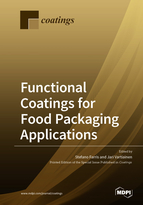Functional Coatings for Food Packaging Applications
A special issue of Coatings (ISSN 2079-6412).
Deadline for manuscript submissions: closed (20 September 2018) | Viewed by 213780
Special Issue Editors
Interests: food packaging; biopolymers; bionanocomposites; functional polymers
Special Issues, Collections and Topics in MDPI journals
Special Issue Information
Dear Colleagues,
The global packaging industry has steadily grown over the recent years, with sales mostly concentrated in Asia, North America, and Western Europe, which together accounted for approximately 80% of the total in value terms. According to recent studies, the segmentation of the market is forecasted to change by 2018, with emerging countries gaining a larger share of the market in North America and Western Europe. The food and beverage sector, in particular, accounts for a large share of global packaging production, with a potential demand growth rate of 3.4%, on average, to 2018. Several reasons drive this growth. Among others, growing urbanization, increased living standards, and personal disposable income in the developing regions play a main role.
The increasing demand for food and beverage packaging materials (especially oil-based plastics) poses serious concerns in terms of environmental impact. Over recent years, several strategies have been undertaken to face the threat associated with the large amount of non-biodegradable plastics dumped into landfills and seas. For example, biodegradable plastics from renewable resources have been considered to be the most promising alternative to plastics of fossil origin. However, high production costs, low performance and, not less important, ethical implications, still hinder the market penetration of bioplastics. Recyclability is similarly deemed as a valid approach for reducing the overall production of plastic packaging materials. However, technical limitations associated with the physicochemical properties of polymers, the economic disadvantages of recycling multi-layer structures and highly contaminated materials, inadequate recycling plants, and lack of incentives invest explain why the only efficient closed loop recycling process for plastics concerns PET bottles.
Of late, coating technology has been proposed as an additional strategy for accomplishing a more rational use of the materials used within the food packaging sector. According to the packaging optimization concept, the use of multifunctional thin layers would allow the replacement of multi-layer and heavy structures, thus reducing the upstream amount of packaging materials, while keeping (or even improving) the functional properties of the final package, so as to pursue the goal of overall shelf life extension. Concurrently, the increasing requirements among consumers for convenience, smaller package sizes, and for minimally processed, fresh, and healthy foods have imposed the necessity of designing highly sophisticated and engineered coatings. To this scope, new chemical pathways, new raw materials (e.g., biopolymers), and non-conventional deposition technologies have been used. Nanotechnology, in particular, paved the way for the development of new architectures and never before seen patterns that eventually yielded nanostructured and nanocomposite coatings with outstanding performances.
This Special Issue of Coatings on "Food and Beverage Packaging Coatings" is intended to cover original research articles as well as critical reviews and perspectives on all aspects related to recent advances in the design and development of coatings for the food and beverage packaging sector (e.g., gas barrier, water vapor barrier, antifog, UV-shield, sealing, and active coatings). Contributions on the potential impact of coatings on environmental issues (e.g., bio-based coating systems, water-based formulations, and recycling of coated materials) are particularly welcome.
Prof. Dr. Stefano Farris
Dr. Jari Vartiainen
Guest Editors
Manuscript Submission Information
Manuscripts should be submitted online at www.mdpi.com by registering and logging in to this website. Once you are registered, click here to go to the submission form. Manuscripts can be submitted until the deadline. All submissions that pass pre-check are peer-reviewed. Accepted papers will be published continuously in the journal (as soon as accepted) and will be listed together on the special issue website. Research articles, review articles as well as short communications are invited. For planned papers, a title and short abstract (about 100 words) can be sent to the Editorial Office for announcement on this website.
Submitted manuscripts should not have been published previously, nor be under consideration for publication elsewhere (except conference proceedings papers). All manuscripts are thoroughly refereed through a single-blind peer-review process. A guide for authors and other relevant information for submission of manuscripts is available on the Instructions for Authors page. Coatings is an international peer-reviewed open access monthly journal published by MDPI.
Please visit the Instructions for Authors page before submitting a manuscript. The Article Processing Charge (APC) for publication in this open access journal is 2600 CHF (Swiss Francs). Submitted papers should be well formatted and use good English. Authors may use MDPI's English editing service prior to publication or during author revisions.
Keywords
- biopolymer coatings
- environmental impact
- functional barrier
- multifunctional coatings
- nanocomposite coatings
- nanostructured coatings
- oxygen barrier coatings
- packaging optimization
- shelf life extension
- Food packaging materials
- Barrier properties







